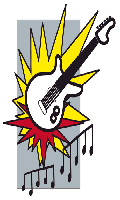Electric Guitar InfoHistory Of The Electric Guitar |
|
|
The electric guitar is one of the most important inventions of the 20th century. It is mainly well known for defining the tone and character of rock and roll music. When the first electric guitar came out in the 1930s, not many people saw its potential and the instrument took quite a while to become popular in American music. In spite of the slow start, the electric guitar did find its place and has inspired and defined new types of music throughout the years. The electric guitar is still the most prominent instrument in rock music and the most famous instrument to have been introduced by the United States. Hawaiian guitars were played in the 1920s and after, which had a metal slide and the Hawaiian electric guitars were the first instruments that depended totally on their sound being amplified electrically rather than just acoustically. Adolph Rickenbacker originally made metal components for Dopera Brothers' National Resonator Guitars. While he was working at National, Rickenbacker metGeorge Beauchamp and Paul Barth who had been developing the magnetic pickups. They formed the Electro String Company together and in 1931 the trio produced their first Hawaiian guitars. This success prompted Gibson and others to start producing electric guitars that would become very popular, Gibson new electric models became established in the 1940s. Guitar makers started to work on ways of applying the solid body of the Hawaiian and steel guitars to regular instruments, to come up with something that sounded good. In 1944, Leo Fender, a radio repair shop owner, teamed up with Doc Kaufman, a former Rickenbacker employee, set up K & F Company and produced some steel guitars and amplifiers. Fender though the large pickup magnets in use at the time could be smaller and still successful. He incorporated a new pickup that he wanted to try out into a solid body guitar based on the Hawaiian shape but using a regular properly fretted fingerboard. He only meant to demonstrate the pickup but this type of guitar was soon in demand. In 1946 the Fender Electric Instrument Company was formed and the Broadcaster was introduced. Les Paul was working in the same direction at about the same time. Paul had been experimenting with pickups in the 1930s but had experienced resonance and feedback problems. This made him start thinking about a solid body guitar after hearing about Thomas Edison´s solid body violin. Paul was sure that the only way to avoid body feedback was to reduce pickup movement so being mounted in a solid body would be essential. Paul built the historic "log" guitar in 1941 after persuading Epiphone to let him use its workshop on Sundays. Paul Bigsby and Merle Travis built a solid body electric guitar in 1947 that was similar to the Broadcaster that Fender introduced in 1948. The two of them were situated near each other so perhaps some copying took place. Fender was more interested in practicality and utility then looks and wanted a regular guitar with the clear sound of an electric Hawaiian. He wanted to get rid of the feedback problems. The result was the Broadcaster that he began producing in 1948 later renamed the Telecaster. Fender started production of the Stratocaster in 1954. With the Telecaster and the guitars Les Paul was designing for Gibson, they set the standard for solid body guitars.
| |
|
Related News About Guitars ' ); // get rid of newsfeed display by carp CarpConf('poweredby',''); CarpCacheShow('http://www.ultimate-guitar.com/modules/rss/news.xml.php'); ?>
|
|
|
|
|
|
Copyright © 2007 electricguitarinfo.com |


